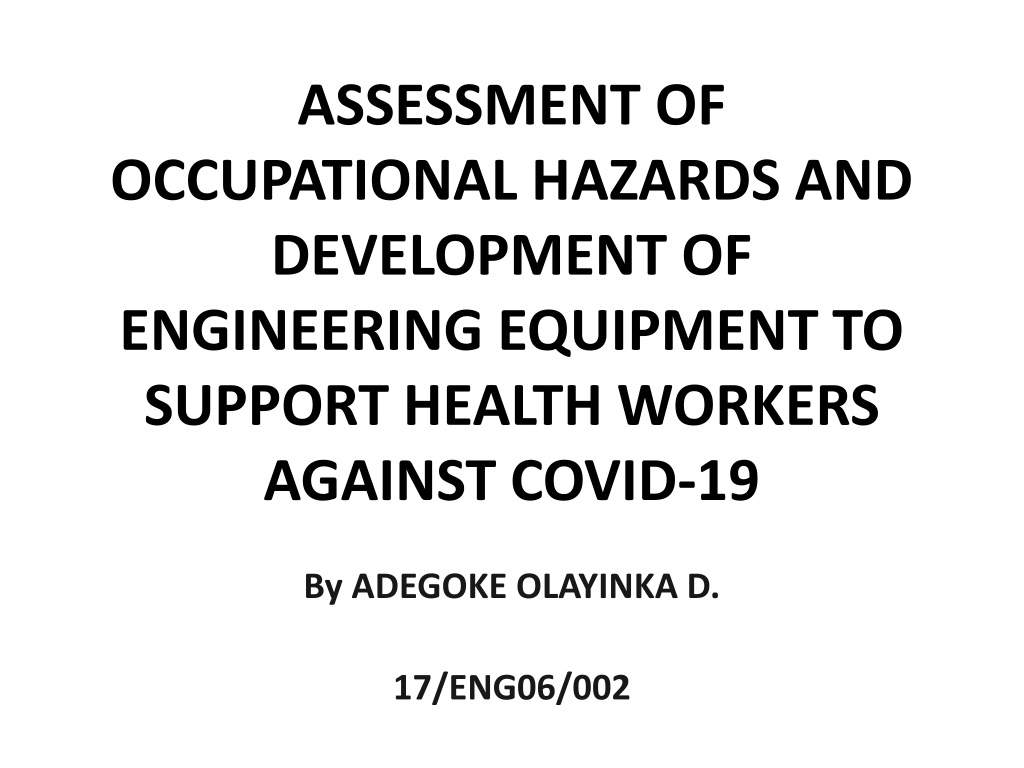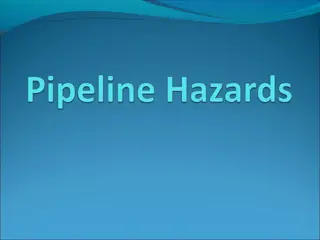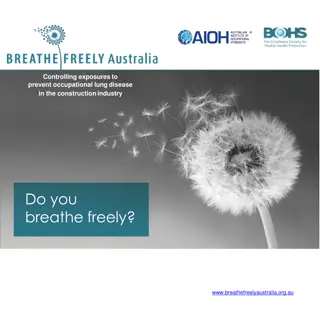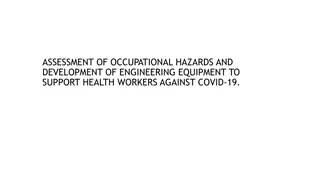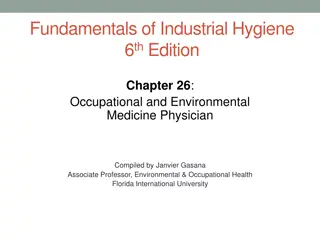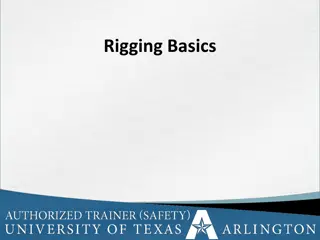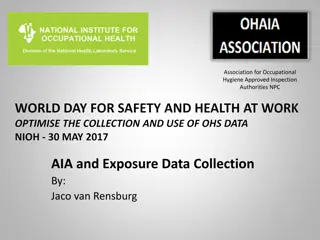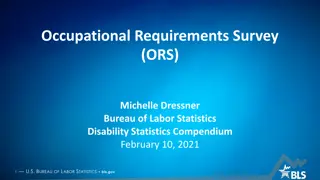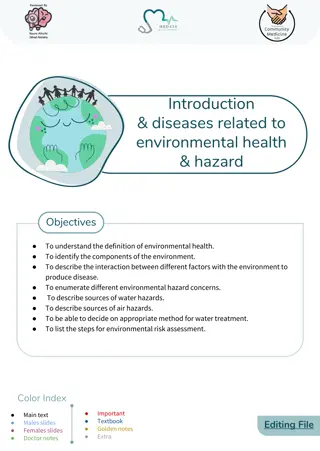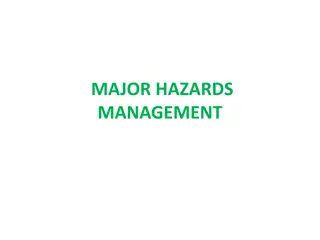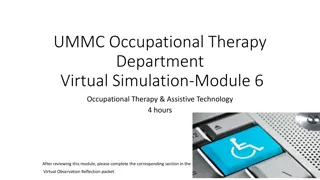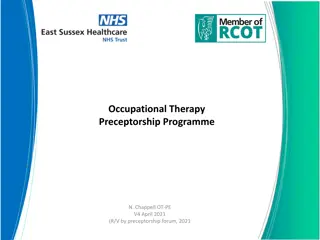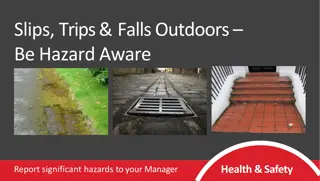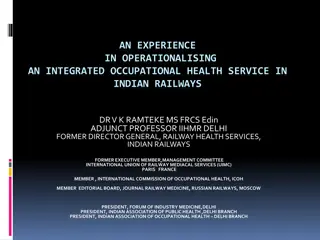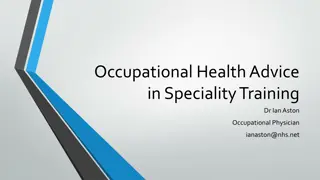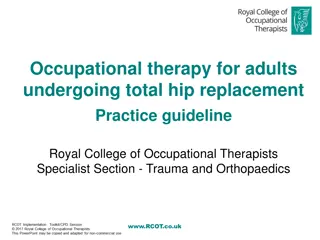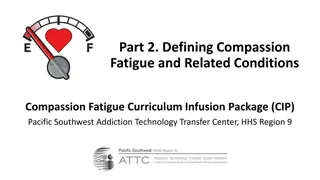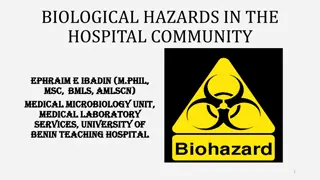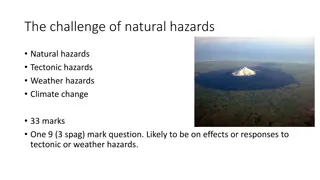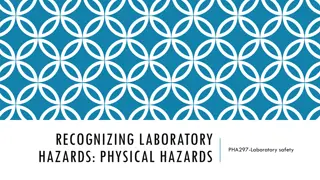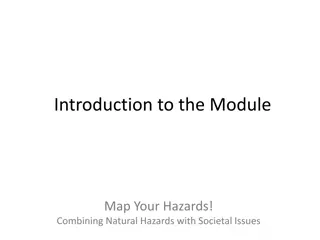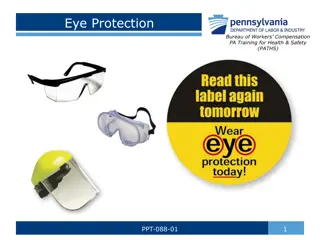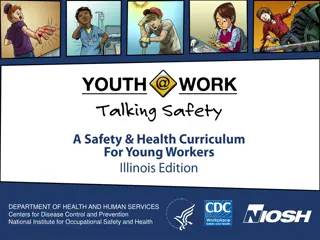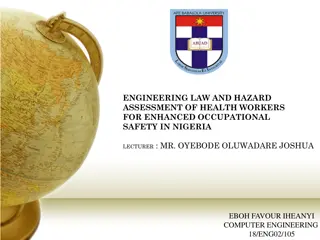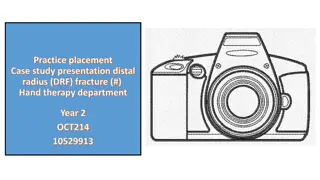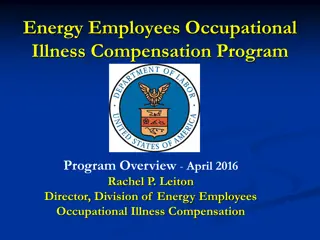Occupational Hazards Assessment and Equipment Development for COVID-19 Protection
COVID-19, caused by a novel coronavirus, poses risks to health workers. Understanding symptoms, modes of transmission, and prevention measures is crucial. Adequate equipment development is essential to support and protect frontline workers.
Download Presentation

Please find below an Image/Link to download the presentation.
The content on the website is provided AS IS for your information and personal use only. It may not be sold, licensed, or shared on other websites without obtaining consent from the author. Download presentation by click this link. If you encounter any issues during the download, it is possible that the publisher has removed the file from their server.
E N D
Presentation Transcript
ASSESSMENT OF OCCUPATIONAL HAZARDS AND DEVELOPMENT OF ENGINEERING EQUIPMENT TO SUPPORT HEALTH WORKERS AGAINST COVID-19 By ADEGOKE OLAYINKA D. 17/ENG06/002
COVID-19 Coronavirus disease (COVID-19) is an infectious disease caused by a newly discovered coronavirus. Most people infected with the COVID-19 virus will experience mild to moderate respiratory illness and recover without requiring special treatment. Older people, and those with underlying medical problems like cardiovascular disease, diabetes, chronic respiratory disease, and cancer are more likely to develop serious illness. The best way to prevent and slow down transmission is be well informed about the COVID-19 virus, the disease it causes and how it spreads. Protect yourself and others from infection by washing your hands or using an alcohol based rub frequently and not touching your face. The COVID-19 virus spreads primarily through droplets of saliva or discharge from the nose when an infected person coughs or sneezes, so it s important that you also practice respiratory etiquette (for example, by coughing into a flexed elbow).At this time, there are no specific vaccines or treatments for COVID-19. However, there are many ongoing clinical trials evaluating potential treatments.
SIGNS AND SYMPTOMS The viruses can make people sick, usually with a mild to moderate upper respiratory tract illness, similar to a common cold. Coronavirus symptoms include a runny nose, cough, sore throat, possibly a headache and maybe a fever, which can last for a couple of days. For those with a weakened immune system, the elderly and the very young, there's a chance the virus could cause a lower, and much more serious, respiratory tract illness like a pneumonia or bronchitis. Those infected with the virus may be asymptomatic or develop flu-like symptoms, including fever, cough, fatigue and shortness of breath. Emergency symptoms include difficulty breathing, persistent chest pain or pressure, confusion, difficulty waking and bluish face or lips; immediate medical attention is advised if these symptoms are present. Less commonly, upper respiratory symptoms, such as sneezing, runny nose or sore throat may be seen. Symptoms such as nausea, vomiting and diarrhoea have been observed in varying percentages. As is common with infections, there is a delay between the moment when a person is infected with the virus and the time when they develop symptoms. This is called the incubation period. The incubation period for COVID-19 is typically five to six days but may range from two to 14 days. 97.5% of people who develop symptoms will do so within 11.5 days of infection.
MODES OF TRANSMISSION Human-to-human transmission has been confirmed during the 2019 20 coronavirus pandemic. Transmission occurs primarily via respiratory droplets from coughs and sneezes within a range of about 1.8 metres (6 ft.). Indirect contact via contaminated surfaces is another possible cause of infection. Preliminary research indicates that the virus may remain viable on plastic and steel for up to three days, but does not survive on cardboard for more than one day or on copper for more than four hours; the virus is inactivated by soap, which destabilises its lipid bilayer. Viral RNA has also been found in stool samples from infected people.
PREVENTIVE MEASURES As the cure for the corona virus disease remains unknown, there are a number of things we can to prevent and avoid further spread of the virus. They include the following: Wash your hands regularly for 20 seconds, with soap and water or alcohol-based hand rub. Cover your nose and mouth with a disposable tissue or flexed elbow when you cough or sneeze. Avoid close contact (1 meter or 3 feet) with people who are unwell. Stay home and self-isolate from others in the household if you feel unwell. Don't touch your eyes, nose, or mouth if your hands are not clean.
ENGINEERING STRATEGIES The basic strategies in the control of an outbreak are containment and mitigation. Containment may be undertaken in the early stages of the outbreak, including contact tracing and isolating infected individuals to stop the disease from spreading to the rest of the population, other public health interventions on infection control, and therapeutic countermeasures such as vaccinations which may be effective if available. When it becomes apparent that it is no longer possible to contain the spread of the disease, management will then move on to the mitigation stage, in which measures are taken to slow the spread of the disease and mitigate its effects on society and the healthcare system. In reality, containment and mitigation measures may be undertaken simultaneously. Another strategy, suppression, requires more extreme long-term non- pharmaceutical interventions so as to reverse the pandemic by reducing the basic reproduction number to less than 1. The suppression strategy, which includes stringent population-wide social distancing, home isolation of cases, and household quarantine, was undertaken by China during the 2019 20 coronavirus pandemic where entire cities were placed under lockdown, but such strategy carries with it considerable social and economic costs. Some of the engineering strategies employed in this current situation are:
HELP MARKSON DEVELOP PROTECTIVE GEAR FOR MEDICAL PERSONNEL Doctors, nurses, and EMTs are desperate for masks and other protective equipmets both for their own safety and that of their patients. Despite extraordinary efforts on the parts of hospital leaders and philanthropists, the demand for protective gears continues to rise. Engineers can use the knowledge of 3 dimensional printing to help speed up the production of these protective gears to decrease the rise in demand for protective gears.
HELP TO DEVELOP AN OPEN-SOURCE VENTILATOR For patients with severe forms of the coronavirus, ventilators are an essential lifeline. Unfortunately, they are also in small number of supplies in hospitals and regions. A team of engineers and medics can help to solve the problem of ventilators shortages with an open souce- source model they are calling the OxVent. While the project is relatively advanced, engineers are working tirelessly to ensure the demands of ventilators are meet in the world in other to have a fighting chance against the corona virus.
CORONA VIRUS ISOLATION PODS Special fully-sealed isolation pods were created by Mexican engineers for safely transporting covid-19 patients. The specially designed pods are equipped with air pumps that create a negative pressure within the sealed space. The negative pressure means that, even if the plastic lining of the pod is torn during the transfer of a patient, any fluid will remain inside the isolation pods which is an ingenious method to stop the spread of the infectious disease amongst health care workers.
CONCLUSION I strongly believe that the above mentioned strategies of engineering in handling the pandemic situation are effectively been carried out to help the victims as well as the rest of the world in taking preventive measures. I also believe that the above mentioned results have also taking great effect in both sides of the world (victims and non-victims).
RECOMMENDATION With respect to the current situation, I recommend the following: People should strictly adhere to the WHO instructions and guidance. People should respect the curfew on movement as social-distancing remains the best tactics to fight the coronavirus People should follow and obey the country s order and protocols. Governments in the country should take responsibility and provide for her citizens, especially those with little or no means of provision. People should use this medium to be creative and engage in one form of activity (legal) or the other from their various homes.
